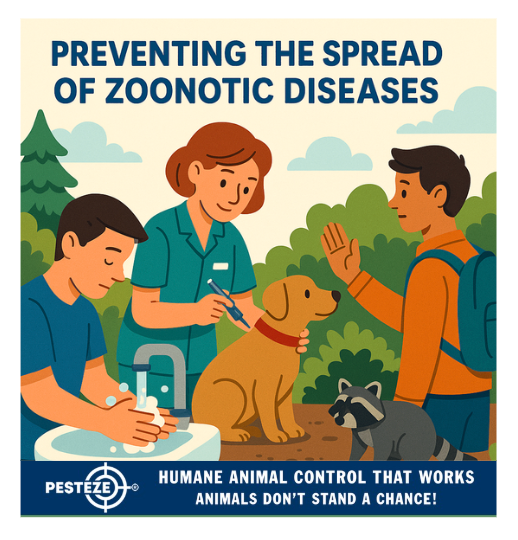PREVENTING THE SPREAD OF ZOONOTIC DISEASES

PREVENTING THE SPREAD OF ZOONOTIC DISEASES
SUMMARY
This guide explains how to reduce the risk of diseases that can spread between animals and humans. It focuses on hygiene, safe wildlife handling, vaccination, and responsible pet care to keep communities and ecosystems healthy.
FEATURES
-
Practice Good Hygiene: Wash hands thoroughly after animal contact.
-
Vaccinate Pets and Livestock: Maintain regular veterinary care and vaccinations.
-
Avoid Direct Wildlife Contact: Observe animals from a safe distance.
-
Proper Waste Management: Dispose of animal waste safely to reduce contamination.
-
Cook Animal Products Thoroughly: Prevent infections from undercooked meat or dairy.
-
Report Sick Animals: Notify local health or wildlife authorities of unusual illnesses.
GUIDE DESCRIPTION
Zoonotic diseases are illnesses that can be transmitted between animals and humans. These diseases—such as rabies, salmonella, and Lyme disease—pose a serious global health concern, especially as human activity increasingly overlaps with wildlife habitats. Preventing their spread requires awareness, hygiene, and responsible interaction with both domestic and wild animals.
The first line of defense is proper hygiene. After handling pets, cleaning cages, or spending time outdoors, always wash your hands with soap and water for at least 20 seconds. Avoid touching your face, especially your mouth and eyes, until you’ve cleaned your hands. Disinfecting tools, surfaces, and feeding areas used for animals is also vital to minimize bacterial and viral spread.
Vaccination plays a crucial role in protecting both animals and humans. Keeping pets and livestock up to date on vaccinations—especially for rabies and other region-specific diseases—helps break the chain of transmission. Regular veterinary checkups ensure that illnesses are caught early and prevented from spreading to humans or other animals.
Limiting direct contact with wildlife is equally important. Wild animals can carry pathogens without showing symptoms, and touching or attempting to feed them can result in bites, scratches, or contamination. If you encounter a sick or injured animal, contact wildlife authorities instead of approaching it yourself. This protects both the animal and your health.
Safe food practices are another cornerstone of zoonotic disease prevention. Always cook meat, poultry, and eggs thoroughly to eliminate pathogens, and avoid consuming unpasteurized milk or dairy products. Store food properly and separate raw meats from ready-to-eat items to prevent cross-contamination.
Environmental cleanliness matters too. Proper waste disposal—including pet waste, litter, and livestock manure—reduces bacteria and parasites that can contaminate soil and water sources. Communities that implement effective sanitation measures significantly lower the risk of zoonotic disease outbreaks.
Finally, report unusual animal behavior or illness to local health departments or animal control agencies. Early detection and monitoring help contain potential outbreaks before they become widespread.
Preventing zoonotic diseases is a shared responsibility between individuals, veterinarians, and public health organizations. By practicing good hygiene, staying informed, and respecting wildlife boundaries, we can create healthier environments for both people and animals.
- Saneeth Thota


Comments 0